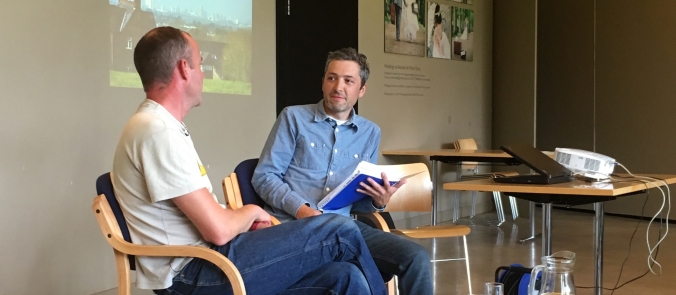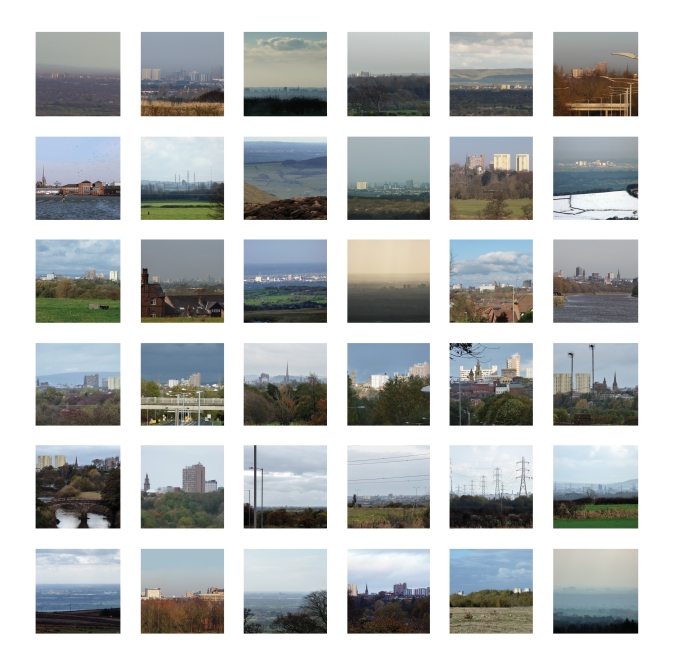
Writer and artist Lauren Velvick reflects on the second Expanded City Network event, Routes In, Routes Out, held at Avenham Park Pavilion in Preston on 27 July 2017.
Gavin Renshaw’s Expanded City research and output continues to oscillate between instrumentalised cycling advocacy and an artistic investigation of landscape that takes into account socio-political and cultural influences. In line with this, for his ‘in-conversation’ event, Renshaw was joined by Jack Thurston, presenter of The Bike Show on Resonance FM. In order that Thurston would be able to speak on the cycling infrastructure of Preston in particular, the day of the event was spent on a ride with Renshaw that was referred to throughout. The cultural history of cycling has been instrumental to Renshaw’s project from the earliest stages, and this was reiterated in order to set the scene for the discussion that followed. In ‘36 Views’, Renshaw’s series of photographs of Preston taken from the vantage point of cycling routes around the periphery of the city (see below), it is easy to discern the links between grand ideas about landscape and the activity of cycling, which offers the ability to move swiftly across the land whilst simultaneously in physical contact with it. This emphasis on the physicality of travelling by bike is reiterated in Renshaw’s consideration of what can be seen from this specific vantage point, and the idea of travelling as far as the eye can see, or perhaps seeing the potential for travel in the landscape.

As a continuation of, and tangent to, Renshaw’s ongoing interests, Thurston emphasised the material links between art and cycling, particularly the nature of cycling as a cheap form of transport and artists as often lacking in disposable income. For his radio show, Thurston developed a method of interviewing by bike, which brings to mind the evident difficulties in cycling two-abreast on the majority of Britain’s roads, and how this is in contrast with the Clarion motto: Fellowship is Life. This point was raised by Renshaw and Thurston during their discussion, whereby if fellowship is life, presumably lack of fellowship must be death, which raises the grim spectre of road deaths and the very real danger inherent in cycling on roads that are not fit for shared use and a motoring culture of resentment towards cyclists. Renshaw drew attention to the sinking feeling provoked by collections of flowers at the sides of roads commemorating those killed, comparing these to plaques installed by cycling clubs that commemorate hill climbs. This tension around cycling as promoted on the one hand and resented on the other was cited by Thurston, who went on to discuss how the very idea of a ‘cycling culture’ indicates a ‘sub culture’. This is a problem, because in order for cycling to be reasonably safe it has to be accepted as a form of transport integral to urban infrastructure, rather than a specialist hobby.
It is clear that both Renshaw and Thurston are deeply invested in cycling both as a form of transport and as a culture of fellowship, however they were also careful to acknowledge that this can engender a kind of elitism. Renshaw raised the issue of how cycling infrastructure is so confusing and disjointed that, even with the best of intentions, it is difficult to navigate for beginners. I’m sure that every city has instances of cycle paths that run directly into walls and the like. There are also the practical issues of protecting a bike from bad weather or arriving at work sweaty and dishevelled after a cycling commute; concerns that can only be addressed by a paradigm shift in how we consider cycling within everyday life. This was acknowledged and expanded on by Thurston, who cautioned against the temptation to replace infrastructure with training, emphasising that coping mechanisms developed by cyclists in order to survive on overcrowded, hostile roads do not constitute solutions. It is valuable to articulate these points in the context of The Expanded City because we are in the rare position of having the opportunity to question the ways that, as Thurston outlined, motoring is essentially subsidised by the rest of society in the form of parking that uses up valuable public space.
